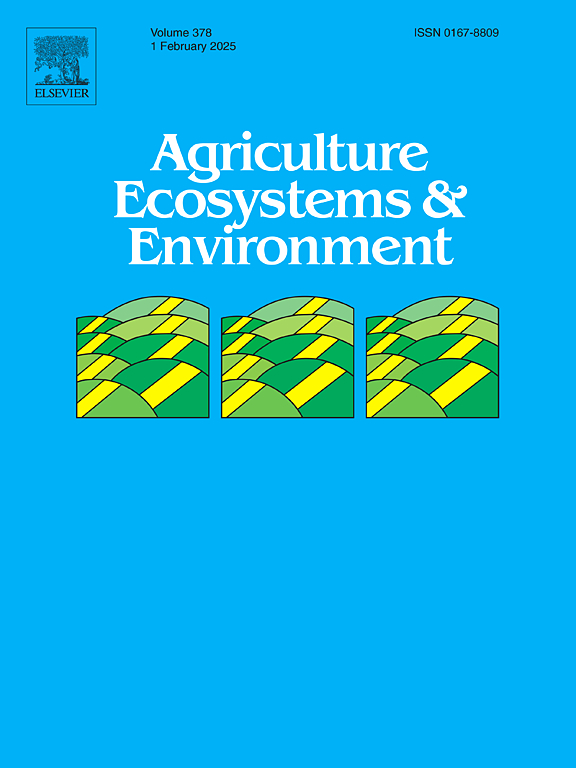Benefit of weeds for crop-plant mycobiota in agroecosystems: Integrating ecological demonstration and management applicability
IF 6
1区 农林科学
Q1 AGRICULTURE, MULTIDISCIPLINARY
引用次数: 0
Abstract
Agricultural intensification reduces not only biodiversity in agroecosystems but also key ecosystem functions such as soil fertility. By reintroducing biological diversity in fields, weeds may enhance soil biological fertility through their influence on crop microbiota. However, letting weeds grow in crop fields will depend on weed competitiveness, farmers’ perception and acceptance, and on crop management, which influences the occurrence and the abundance of weeds in the field. This study assessed the use of eight weed species to modify wheat plant root endospheric mycobiota, and the applicability of using these plants for mycobiota enrichment in the field. By combining controlled lab experiments and field studies, we demonstrated that weeds act either as a refuge for a high diversity of fungi or as a vector for transferring fungi to the crop, particularly symbionts. Weeds differed in their competitive effect on wheat growth and only three species significantly reduced wheat growth. Interviews with farmers’ revealed that weed species were better known and more appreciated in crop fields by organic farmers than by conventional farmers. Floristic surveys confirmed that both weed occurrence and cover were higher in organic fields than in conventional fields. A multicriteria analysis showed that Trifolium repens and V. persica had the highest potential for promoting wheat plant mycobiota. Among the weed species tested, these two are worth considering as auxiliaries to improve soil biological fertility in crop fields. Their use with the goal of selecting appropriate crop mycobiota should be relatively easier in organic farms where weeds are better accepted, whereas their use in conventional farms would require raising farmers’ awareness of the benefits of weeds for soil fertility.
杂草对农业生态系统中作物-植物菌群的益处:生态示范与管理适用性相结合
农业集约化不仅降低了农业生态系统的生物多样性,也降低了土壤肥力等关键生态系统功能。通过在田间重新引入生物多样性,杂草可通过影响作物微生物群提高土壤的生物肥力。然而,让杂草在作物田中生长将取决于杂草的竞争力、农民的认知和接受程度以及作物管理,而作物管理又会影响杂草在田中的出现和数量。本研究评估了利用八种杂草来改变小麦植物根部内生菌群的情况,以及利用这些植物来丰富田间菌群的适用性。通过将对照实验室实验和田间研究相结合,我们证明杂草既可以作为高真菌多样性的庇护所,也可以作为向作物转移真菌(尤其是共生真菌)的载体。杂草对小麦生长的竞争效应各不相同,只有三种杂草会显著降低小麦的生长。与农民的访谈显示,与传统农民相比,有机农民对作物田中的杂草物种更了解,也更重视。花卉调查证实,有机农田的杂草发生率和覆盖率均高于传统农田。多标准分析表明,Trifolium repens 和 V. persica 在促进小麦植物菌群方面的潜力最大。在测试的杂草物种中,这两种值得考虑作为改善作物田土壤生物肥力的辅助物种。在杂草接受度较高的有机农场,使用它们来选择合适的作物菌群应该相对容易,而在传统农场使用它们则需要提高农民对杂草对土壤肥力益处的认识。
本文章由计算机程序翻译,如有差异,请以英文原文为准。
求助全文
约1分钟内获得全文
求助全文
来源期刊

Agriculture, Ecosystems & Environment
环境科学-环境科学
CiteScore
11.70
自引率
9.10%
发文量
392
审稿时长
26 days
期刊介绍:
Agriculture, Ecosystems and Environment publishes scientific articles dealing with the interface between agroecosystems and the natural environment, specifically how agriculture influences the environment and how changes in that environment impact agroecosystems. Preference is given to papers from experimental and observational research at the field, system or landscape level, from studies that enhance our understanding of processes using data-based biophysical modelling, and papers that bridge scientific disciplines and integrate knowledge. All papers should be placed in an international or wide comparative context.
 求助内容:
求助内容: 应助结果提醒方式:
应助结果提醒方式:


